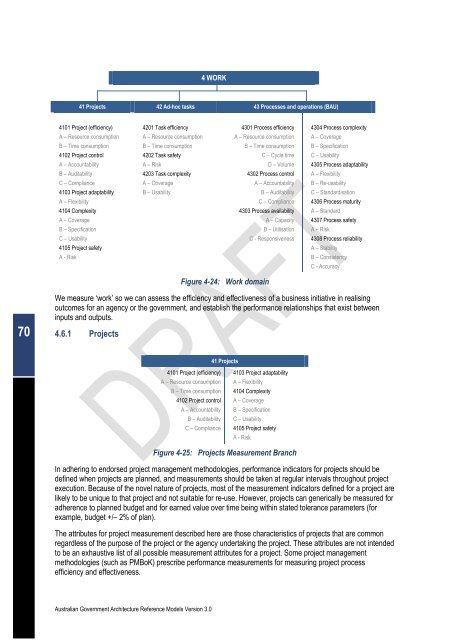Australian Government Architecture Reference Models Version 3.0
Australian Government Architecture Reference Models Version 3.0
Australian Government Architecture Reference Models Version 3.0
Create successful ePaper yourself
Turn your PDF publications into a flip-book with our unique Google optimized e-Paper software.
70<br />
<strong>Australian</strong> <strong>Government</strong> <strong>Architecture</strong> <strong>Reference</strong> <strong>Models</strong> <strong>Version</strong> <strong>3.0</strong><br />
4 WORK<br />
41 Projects 42 Ad-hoc tasks 43 Processes and operations (BAU)<br />
4101 Project (efficiency)<br />
A – Resource consumption<br />
B – Time consumption<br />
4102 Project control<br />
A – Accountability<br />
B – Auditability<br />
C – Compliance<br />
4103 Project adaptability<br />
A – Flexibility<br />
4104 Complexity<br />
A – Coverage<br />
B – Specification<br />
C – Usability<br />
4105 Project safety<br />
A - Risk<br />
4201 Task efficiency<br />
A – Resource consumption<br />
B – Time consumption<br />
4202 Task safety<br />
A – Risk<br />
4203 Task complexity<br />
A – Coverage<br />
B – Usability<br />
4301 Process efficiency<br />
A – Resource consumption<br />
B – Time consumption<br />
C – Cycle time<br />
D – Volume<br />
4302 Process control<br />
A – Accountability<br />
B – Auditability<br />
C – Compliance<br />
4303 Process availability<br />
Figure 4-24: Work domain<br />
A – Capacity<br />
B – Utilisation<br />
C - Responsiveness<br />
4304 Process complexity<br />
A – Coverage<br />
B – Specification<br />
C – Usability<br />
4305 Process adaptability<br />
A – Flexibility<br />
B – Re-usability<br />
C – Standardisation<br />
4306 Process maturity<br />
A – Standard<br />
4307 Process safety<br />
A – Risk<br />
4308 Process reliability<br />
A – Stability<br />
B – Consistency<br />
C - Accuracy<br />
We measure ‘work’ so we can assess the efficiency and effectiveness of a business initiative in realising<br />
outcomes for an agency or the government, and establish the performance relationships that exist between<br />
inputs and outputs.<br />
4.6.1 Projects<br />
4101 Project (efficiency)<br />
A – Resource consumption<br />
B – Time consumption<br />
4102 Project control<br />
A – Accountability<br />
B – Auditability<br />
C – Compliance<br />
41 Projects<br />
4103 Project adaptability<br />
A – Flexibility<br />
4104 Complexity<br />
A – Coverage<br />
B – Specification<br />
C – Usability<br />
4105 Project safety<br />
A - Risk<br />
Figure 4-25: Projects Measurement Branch<br />
In adhering to endorsed project management methodologies, performance indicators for projects should be<br />
defined when projects are planned, and measurements should be taken at regular intervals throughout project<br />
execution. Because of the novel nature of projects, most of the measurement indicators defined for a project are<br />
likely to be unique to that project and not suitable for re-use. However, projects can generically be measured for<br />
adherence to planned budget and for earned value over time being within stated tolerance parameters (for<br />
example, budget +/– 2% of plan).<br />
The attributes for project measurement described here are those characteristics of projects that are common<br />
regardless of the purpose of the project or the agency undertaking the project. These attributes are not intended<br />
to be an exhaustive list of all possible measurement attributes for a project. Some project management<br />
methodologies (such as PMBoK) prescribe performance measurements for measuring project process<br />
efficiency and effectiveness.

















